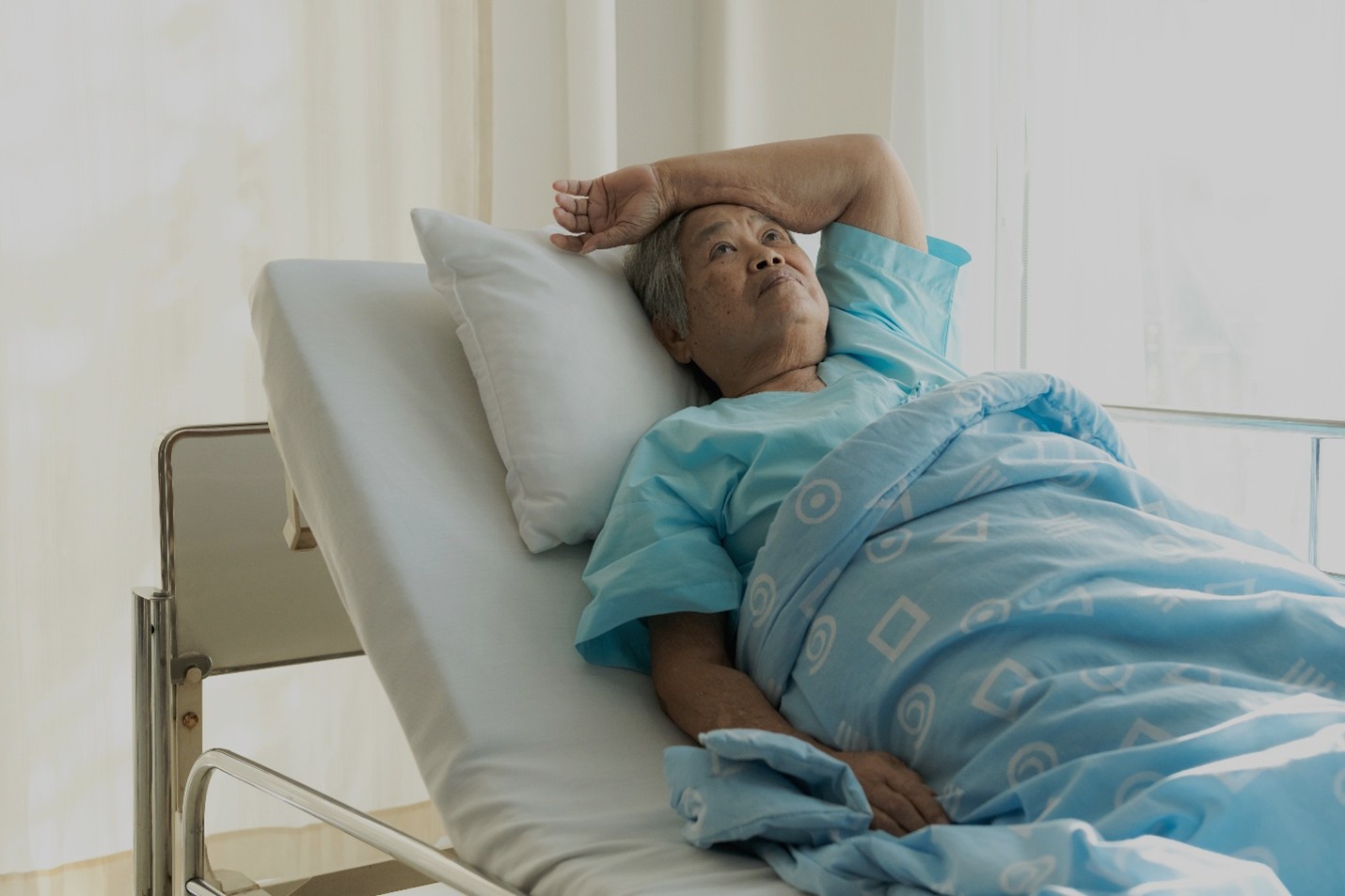What are pressure sores?
Pressure sores are sores on your skin. They’re caused by being in a bed or wheelchair nearly all the time. Sometimes they’re called bedsores or pressure ulcers. The sores usually develop over the bony parts of your body. Those are places with little padding from fat. Sores are common on heels and hips. Other areas include the base of the spine (tailbone), shoulder blades, the backs and sides of the knees, and the back of the head.
People who need to stay in bed or in a wheelchair for a long time are at greater risk of developing pressure sores. This can include people who are paralyzed and those who aren’t able to get up on their own. But even some people with short-term illness and injuries can get pressure sores. Sores can happen if they have to stay in bed or a wheelchair while they heal. Lastly, some chronic (long-lasting) diseases make it hard for pressure sores to heal. Those include diabetes and hardening of the arteries.
Symptoms of pressure sores
Pressure sores go through 4 stages:
- Stage 1. During this stage, the area of the sore looks red. It may feel warm to the touch. It may burn, hurt, or itch. The pressure sore may look blue or purple in people who have dark skin.
- Stage 2. During this stage, the area is more damaged. The sore may be open. It may look like a cut or blister. The skin around the sore may be discolored. The sore is painful.
- Stage 3. During this stage, the sore will have a crater-like look. This is due to increased damage below the surface. This makes the wound deeper.
- Stage 4. This is the most serious stage. Skin and tissue are severely damaged. The sore becomes a large wound. Infection is possible. You’re likely able to see muscle, bones, tendons, and joints.
Infected pressure sores take a long time to heal. Also, the infection can spread to the rest of your body.
Signs of infection at the site include:
- Thick, yellow, or green pus
- A bad smell coming from the sore
- Redness or skin that is warm to the touch
- Swelling around the sore
- Tenderness around the sore
Signs that the infection has spread include:
- Fever
- Chills
- Confusion or difficulty concentrating
- Rapid heartbeat
- Weakness
What causes pressure sores?
Pressure sores are caused by sitting or lying in one position for too long. It’s important to know that a pressure sore can start quickly. In fact, a Stage 1 sore can occur if you stay in the same position for as little as 2 hours. This puts pressure on certain areas of your body. It reduces blood supply to the skin and the tissue under the skin. If you don’t change position frequently, the blood supply will drop. A sore will develop.
How are pressure sores diagnosed?
Your doctor will do a physical exam to look at the sores. They will examine the size and depth of the sore and look to see if blood or fluid is oozing from the sore. Your doctor will check to see if your sore has a bad smell. They also will check for additional sores.
Testing may help to diagnose pressure sores or their complications. These tests might include a blood test. Another test would be to take a sample of the tissue from the sore. This is done by scraping or cutting it from the sore. That sample is sent to the lab for examination.
Can pressure sores be prevented or avoided?
The best way to prevent pressure sores is to avoid spending long periods of time in a chair, wheelchair, or bed. If you’re unable to move on your own, make arrangements for somebody—such as a family member, friend, or caregiver—to help you move.
If you must spend a lot of time in a chair, wheelchair, or bed, check your entire body daily. Look for spots, color changes, or other signs of sores. Pay attention to the pressure points where sores are most likely to occur. Again, if you’re unable to look on your own, ask someone to help you.
Another way to avoid pressure sores is to keep your skin healthy. This includes keeping it clean and dry. Wash it with mild soap and warm water. Don’t use hot water. Apply lotion often.
Even small amounts of exercise can help prevent pressure sores. That’s because exercise improves blood flow, strengthens your muscles, and improves your overall health. Talk to your doctor if physical activity is difficult. They can suggest certain exercises. Your doctor also may refer you to a physical therapist. They can show you how to do exercises that fit with your current health condition.
Lastly, if you smoke, quit. Smoking increases your risk of pressure sores.
Pressure sores treatment
Treatment depends on the seriousness of the sore. If the sore is infected, you may be able to treat it by applying an antibiotic cream to the area. If bone or deeper tissues are infected, you may require antibiotics. These may be taken by mouth (orally) or by a shot or IV (injection).
Other things that can help include:
- Move often. When in bed, change your position at least every 2 hours. If you’re sitting, change positions every 15 minutes. Ask for help, if needed.
- Use foam pads or pillows to take pressure off the sore. Special mattresses, mattress covers, foam wedges, or seat cushions provide support in bed or in a chair. When in bed, avoid resting directly on your hip bone when you’re lying on your side. It can help to use pillows under one side so that your weight rests on the fatty part of your buttocks instead of on your hip bone. If you’re lying on your back, place a pillow under your lower calves to lift your ankles slightly off the bed.
- Sit upright and straight when sitting in a chair or wheelchair. This allows you to move more easily and help prevent new sores.
- Improve your nutrition.This helps heal the sores.
- Maintain good hygiene. Stage 1 sores can be cleaned with mild soap and water. Clean stage 2 sores with a salt and water solution. The saltwater removes extra fluid and loose material. Your doctor or nurse can show you how to clean stage 1 and 2 pressure sores. Your doctor or nurse will likely need to clean stage 3 and 4 pressure sores because of their seriousness.
Living with pressure sores
Living with pressure sores requires a plan to move and turn frequently. Good hygiene will always be required. Pressure sores should be kept covered with a bandage or dressing. Sometimes gauze is used. The gauze must be changed once a day. Newer materials include a see-through film and a hydrocolloid dressing. A hydrocolloid dressing is a bandage made of a gel. It molds to the pressure sore and promotes healing and skin growth. These dressings can stay on for several days at a time.
Dead tissue in the sore can interfere with healing and lead to infection. Dead tissue looks like a scab. To remove dead tissue, rinse the sore every time you change the bandage. Special dressings can help your body dissolve the dead tissue on its own. The dressing must be left in place for several days. Another way to remove dead tissue is to put wet gauze bandages on the sore. Allow them to dry. The dead tissue sticks to the gauze until it is removed. For severe pressure sores, dead tissue must be removed surgically by your doctor.
Removing dead tissue and cleaning the sore can hurt. Your doctor can suggest a pain medicine. Take it 30 to 60 minutes before changing the dressing.
Healthy eating helps sores heal. Make sure you’re eating the proper number of calories and protein every day. Nutrients are important too, including vitamin C and zinc. Ask your doctor for advice on a healthy diet. Be sure to tell them if you’ve lost or gained weight recently.
As pressure sores heal, they get smaller. Less fluid drains from them. New, healthy tissue starts growing at the bottom of the sore. This new tissue is light red or pink. It looks lumpy and shiny. Treatment may take 2 to 4 weeks before you see signs of healing.




